AAO-NANOS Neuro-Ophthalmology Clinical Collection: Derived from the AAO-NANOS Clinical Neuro-Ophthalmology collection produced on CD. The images are of selected cases from the NANOS teaching slide exchange, and the CD was produced under the direction of Larry Frohman, MD and Andrew Lee, MD.
The American Academy of Ophthalmology (AAO); The North American Neuro-Ophthalmology Association (NANOS).
NOVEL: https://novel.utah.edu/
TO
| Title | Creator | Description | ||
|---|---|---|---|---|
| 1 |
 |
Motility Disturbances | Larry P. Frohman, MD | A 27-year-old healthy man presented for neuro-ophthalmologic evaluation for recurrent vertical binocular diplopia. In 1982, he had a minor blow to the head, and 12 days later he sustained vertical binocular diplopia, worse on downgaze, without ever having diurnal variation. His sense of taste was al... |
| 2 |
 |
Motility Disturbances | Larry P. Frohman, MD | A 27-year-old healthy man presented for neuro-ophthalmologic evaluation for recurrent vertical binocular diplopia. In 1982, he had a minor blow to the head, and 12 days later he sustained vertical binocular diplopia, worse on downgaze, without ever having diurnal variation. His sense of taste was al... |
| 3 |
 |
Motility Disturbances | Larry P. Frohman, MD | A 27-year-old healthy man presented for neuro-ophthalmologic evaluation for recurrent vertical binocular diplopia. In 1982, he had a minor blow to the head, and 12 days later he sustained vertical binocular diplopia, worse on downgaze, without ever having diurnal variation. His sense of taste was al... |
| 4 |
 |
Motility Disturbances | Larry P. Frohman, MD | A 27-year-old healthy man presented for neuro-ophthalmologic evaluation for recurrent vertical binocular diplopia. In 1982, he had a minor blow to the head, and 12 days later he sustained vertical binocular diplopia, worse on downgaze, without ever having diurnal variation. His sense of taste was al... |
| 5 |
 |
Motility Disturbances | Larry P. Frohman, MD | A 27-year-old healthy man presented for neuro-ophthalmologic evaluation for recurrent vertical binocular diplopia. In 1982, he had a minor blow to the head, and 12 days later he sustained vertical binocular diplopia, worse on downgaze, without ever having diurnal variation. His sense of taste was al... |
| 6 |
 |
Motility Disturbances | Larry P. Frohman, MD | A 27-year-old healthy man presented for neuro-ophthalmologic evaluation for recurrent vertical binocular diplopia. In 1982, he had a minor blow to the head, and 12 days later he sustained vertical binocular diplopia, worse on downgaze, without ever having diurnal variation. His sense of taste was al... |
| 7 |
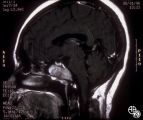 |
Systemic Disorders With Optic Nerve and Retinal Findings | Larry P. Frohman, MD | This 48-year-old female was seen in May 1996 with a history of 2 months of diplopia from a right abducens palsy. This was due to the recurrence of myeloma that had initially been diagnosed and treated with radiation and chemotherapy 9 years before and required further therapy, including bone marrow ... |
| 8 |
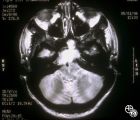 |
Systemic Disorders With Optic Nerve and Retinal Findings | Larry P. Frohman, MD | This 48-year-old female was seen in May 1996 with a history of 2 months of diplopia from a right abducens palsy. This was due to the recurrence of myeloma that had initially been diagnosed and treated with radiation and chemotherapy 9 years before and required further therapy, including bone marrow ... |
| 9 |
 |
Systemic Disorders With Optic Nerve and Retinal Findings | Larry P. Frohman, MD | This 48-year-old female was seen in May 1996 with a history of 2 months of diplopia from a right abducens palsy. This was due to the recurrence of myeloma that had initially been diagnosed and treated with radiation and chemotherapy 9 years before and required further therapy, including bone marrow ... |
| 10 |
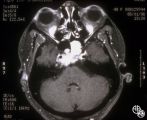 |
Systemic Disorders With Optic Nerve and Retinal Findings | Larry P. Frohman, MD | This 48-year-old female was seen in May 1996 with a history of 2 months of diplopia from a right abducens palsy. This was due to the recurrence of myeloma that had initially been diagnosed and treated with radiation and chemotherapy 9 years before and required further therapy, including bone marrow ... |
| 11 |
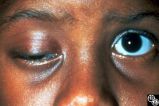 |
Motility Disturbances | Rosa A. Tang, MD | Cyclical oculomotor paresis may occur in patients as an intermittent phenomenon, with a paretic phase and diplopia and intervals that are nonparetic. The history and examination are classic for the disorder. Pair with Images 95_19 and 95_20. |
| 12 |
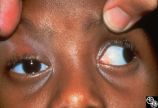 |
Motility Disturbances | Rosa A. Tang, MD | Cyclical oculomotor paresis may occur in patients as an intermittent phenomenon, with a paretic phase and diplopia and intervals that are nonparetic. The history and examination are classic for the disorder. Pair with Images 95_18 and 95_19. |
| 13 |
 |
Motility Disturbances | Rosa A. Tang, MD | Cyclical oculomotor paresis may occur in patients as an intermittent phenomenon, with a paretic phase and diplopia and intervals that are nonparetic. The history and examination are classic for the disorder. Pair with Images 95_18 and 95_20. |
| 14 |
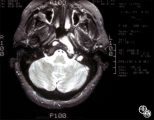 |
Neuro-Ophthalmic Manifestations of Brain Tumors | Jacqueline A. Leavitt, MD | Chordomas of the clivus may result in diplopia due to a sixth nerve palsy. The sixth nerve runs up the clivus and may be the presenting manifestation of the lesion. Pair with Images 97_33, 97_34, and 97_35. |
| 15 |
 |
Neuro-Ophthalmic Manifestations of Brain Tumors | Jacqueline A. Leavitt, MD | Chordomas of the clivus may result in diplopia due to a sixth nerve palsy. The sixth nerve runs up the clivus and may be the presenting manifestation of the lesion. Pair with Images 97_34, 97_35, and 97_36. |
| 16 |
 |
Neuro-Ophthalmic Manifestations of Brain Tumors | Jacqueline A. Leavitt, MD | Chordomas of the clivus may result in diplopia due to a sixth nerve palsy. The sixth nerve runs up the clivus and may be the presenting manifestation of the lesion. Pair with Images 97_33, 97_34, and 97_36. |
| 17 |
 |
Motility Disturbances | Thomas R. Wolf, MD | The patient is a 53-year-old man with diplopia from right oculomotor nerve palsy and left hemiparesis (Weber's syndrome), with associated left lung hilar mass. The spinal tap showed pleocytosis consistent with carcinomatous meningitis. This image demonstrates oculomotor nerve metastatic carcinomatos... |
| 18 |
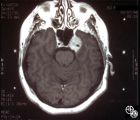 |
Neuro-Ophthalmic Manifestations of Brain Tumors | Jacqueline A. Leavitt, MD | Chordomas of the clivus may result in diplopia due to a sixth nerve palsy. The sixth nerve runs up the clivus and may be the presenting manifestation of the lesion. Imaging: MRI, T-1 axial with contrast. Pair with Images 97_33, 97_34, and 97_36. Anatomy: Clivus, Sixth nerve. Pathology: Sixth nerve p... |
| 19 |
 |
Neuro-Ophthalmic Vascular Disease | Anthony C. Arnold, MD | This 76-year-old woman has a 7-month history of redness and pressure sensation in both eyes that is worse in the morning. She has noted intermittent horizontal diplopia during this time. Angiography demonstrated a right dural cavernous sinus fistula, which was successfully occluded with direct injec... |
| 20 |
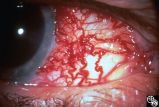 |
Neuro-Ophthalmic Vascular Disease | Anthony C. Arnold, MD | This 76-year-old woman has a 7-month history of redness and pressure sensation in both eyes that is worse in the morning. She has noted intermittent horizontal diplopia during this time. Angiography demonstrated a right dural cavernous sinus fistula, which was successfully occluded with direct injec... |
| 21 |
 |
Neuro-Ophthalmic Vascular Disease | Anthony C. Arnold, MD | This 76-year-old woman has a 7-month history of redness and pressure sensation in both eyes that is worse in the morning. She has noted intermittent horizontal diplopia during this time. Angiography demonstrated a right dural cavernous sinus fistula, which was successfully occluded with direct injec... |
| 22 |
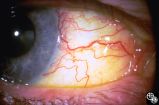 |
Neuro-Ophthalmic Vascular Disease | Anthony C. Arnold, MD | This 76-year-old woman has a 7-month history of redness and pressure sensation in both eyes that is worse in the morning. She has noted intermittent horizontal diplopia during this time. Angiography demonstrated a right dural cavernous sinus fistula, which was successfully occluded with direct injec... |
| 23 |
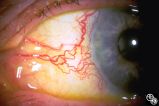 |
Neuro-Ophthalmic Vascular Disease | Anthony C. Arnold, MD | This 76-year-old woman has a 7-month history of redness and pressure sensation in both eyes that is worse in the morning. She has noted intermittent horizontal diplopia during this time. Angiography demonstrated a right dural cavernous sinus fistula, which was successfully occluded with direct injec... |
| 24 |
 |
Neuro-Ophthalmic Vascular Disease | Anthony C. Arnold, MD | This coronal CT scan shows the enlarged superior ophthalmic vein in the left orbit. This 76-year-old woman has a 7-month history of redness and pressure sensation in both eyes that is worse in the morning. She has noted intermittent horizontal diplopia during this time. Angiography demonstrated a ri... |
| 25 |
 |
Pupillary Syndrome | Jeffrey G. Odel, MD | Intermittent dilation of the pupils may occur as a benign phenomenon in healthy young adults. In the absence of other third nerve signs, (eg, ptosis, diplopia, ophthalmoplegia), an isolated transient dilation of the pupil in an otherwise healthy adult is unlikely to represent a third nerve palsy. Tr... |
